
Sir Lawrence Alma-Tadema,, RWS was a Dutch painter who later settled in the United Kingdom, becoming the last officially recognised denizen in 1873. Born in Dronryp, the Netherlands, and trained at the Royal Academy of Antwerp, Belgium, he settled in London, England in 1870 and spent the rest of his life there.

Sir John Everett Millais, 1st Baronet was an English painter and illustrator who was one of the founders of the Pre-Raphaelite Brotherhood. He was a child prodigy who, aged eleven, became the youngest student to enter the Royal Academy Schools. The Pre-Raphaelite Brotherhood was founded at his family home in London, at 83 Gower Street. Millais became the most famous exponent of the style, his painting Christ in the House of His Parents (1849–50) generating considerable controversy, and he produced a picture that could serve as the embodiment of the historical and naturalist focus of the group, Ophelia, in 1851–52.

Henry Scott Tuke, was an English artist; primarily a painter, but also a photographer. His most notable work was in the Impressionist style, and he is best known for his paintings of nude boys and young men.
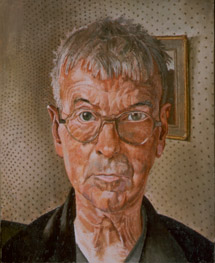
Sir Stanley Spencer, CBE RA was an English painter. Shortly after leaving the Slade School of Art, Spencer became well known for his paintings depicting Biblical scenes occurring as if in Cookham, the small village beside the River Thames where he was born and spent much of his life. Spencer referred to Cookham as "a village in Heaven" and in his biblical scenes, fellow-villagers are shown as their Gospel counterparts. Spencer was skilled at organising multi-figure compositions such as in his large paintings for the Sandham Memorial Chapel and the Shipbuilding on the Clyde series, the former being a First World War memorial while the latter was a commission for the War Artists' Advisory Committee during the Second World War.

Sir Samuel Luke Fildes was a British painter and illustrator born in Liverpool and trained at the South Kensington and Royal Academy Schools. He was the grandson of the political activist Mary Fildes.
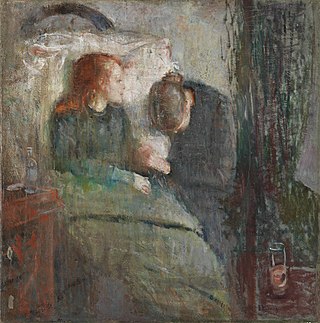
The Sick Child is the title given to a group of six paintings and a number of lithographs, drypoints and etchings completed by the Norwegian artist Edvard Munch between 1885 and 1926. All record a moment before the death of his older sister Johanne Sophie (1862–1877) from tuberculosis at 15. Munch returned to this deeply traumatic event repeatedly in his art over a period of more than 40 years. In the works, Sophie is typically shown on her deathbed accompanied by a dark-haired, grieving woman assumed to be her aunt Karen; the studies often show her in a cropped head shot. In all the painted versions Sophie is sitting in a chair, obviously suffering from pain, propped by a large white pillow, looking towards an ominous curtain likely intended as a symbol of death. She is shown with a haunted expression, clutching hands with a grief-stricken older woman who seems to want to comfort her but whose head is bowed as if she cannot bear to look the younger girl in the eye.
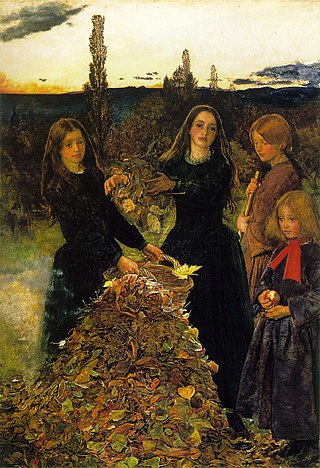
Autumn Leaves (1856) is a painting by John Everett Millais exhibited at the Royal Academy in 1856. It was described by the critic John Ruskin as "the first instance of a perfectly painted twilight." Millais's wife Effie wrote that he had intended to create a picture that was "full of beauty and without a subject".

The Lady of Shalott is a painting of 1888 by the English painter John William Waterhouse. It is a representation of the ending of Alfred, Lord Tennyson's 1832 poem of the same name. Waterhouse painted three versions of this character, in 1888, 1894 and 1915. It is one of his most famous works, which adopted much of the style of the Pre-Raphaelite Brotherhood, though Waterhouse was painting several decades after the Brotherhood split up during his early childhood.

Balthasar van den Bossche (1681–1715) was a Flemish painter who is mainly known for his wide range of genre subjects and occasional portraits.

The Agnew Clinic is an 1889 oil painting by American artist Thomas Eakins. It was commissioned to honor anatomist and surgeon David Hayes Agnew, on his retirement from teaching at the University of Pennsylvania.

Ecce Ancilla Domini, or The Annunciation, is an oil painting by the English artist Dante Gabriel Rossetti, first painted in 1850 and now in Tate Britain in London. The Latin title is a quotation from the Vulgate text of the first chapter of the Gospel of Saint Luke, describing the Annunciation, where Mary accepts the message brought to her by the Angel Gabriel that she would give birth to a child (Jesus) by God.
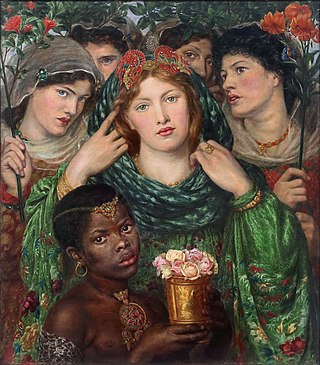
The Beloved is an oil painting on canvas by the English artist Dante Gabriel Rossetti (1828–1882), now in Tate Britain, London. Rossetti signed his initials and the date as "1865-6" on the bottom left of the canvas. It depicts the bride, or "beloved", from the Song of Solomon in the Hebrew Bible as she approaches her bridegroom, with her attendants.

Gaetano Giuseppe Faostino Meo was an Italian-British artist's model, landscape painter, and a noted craftsman in mosaic and stained glass. His unpublished autobiography is a useful source for art historians of the Aesthetic Movement and Edwardian Era.

Henry Woods was a British painter and illustrator, and one of the leading Neo-Venetian school artists.

Science and Charity is an oil on canvas painting by Pablo Picasso, which he painted in Barcelona in 1897. It is an example of one of Picasso's earliest works, as he painted it when he was only 15 years old. The painting depicts a formal composition of a sick patient in bed, attended by a doctor and a nun holding a child. It was the culmination of Picasso's academic training and displays his talent as an artist before he moved away from this style to pursue his own artistic career. The painting is housed in the collection of the Museu Picasso, Barcelona.
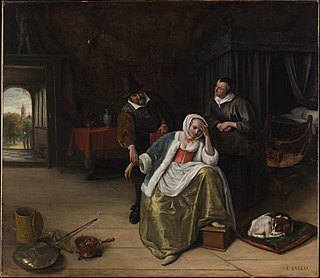
The Lovesick Maiden is a c. 1660 oil-on-canvas genre painting by Jan Steen. It shows a young woman suffering from love-sickness surrounded by her doctor and a maid-servant. It is in the collection of the Metropolitan Museum of Art.

Thomas Lovell Buzzard MD FRCP was a Victorian English doctor who worked at the National Hospital, Queen Square. He was a pioneering neurologist who founded an epilepsy society and wrote also on Parkinson's disease. One of the last doctors to be trained through the apprenticeship route, Buzzard witnessed the Crimean War and later was a role model for the famous painting The Doctor.

Gustavus Charles Philip Murray was a British obstetrician who may have been the inspiration for Luke Fildes' 1891 painting The Doctor. His work in the examination of pregnant women was recognised by Adolphe Pinard in 1889 but ignored in England. He was popular with his patients and had a thriving practice with many professional appointments but as a result wrote little. He died at the age of 56 years from heart failure.

Applicants for Admission to a Casual Ward is an 1874 oil painting by British painter Luke Fildes, a key work in nineteenth-century British social realism. The painting shows a street scene of impoverished and weary men, women and children waiting by the side of the road outside a police station, huddled against the cold evening, waiting to be given a ticket for temporary admission to a workhouse for the night. Many resisted taking up permanent residence at the workhouse, where men and women would be separated, and would be required to work to pay for their board and lodging; once they entered, many only left when they died. Instead, from 1864, if the police in London certified that a person was genuinely in need, they could stay for one night on a "casual" basis, and leave the next morning, but they would have to queue up again for temporary admission the next evening. Poverty and vagrancy were pressing issues in Victorian London, and the issuance of "casual" tickets doubled from around 200,000 in 1864 to over 400,000 in 1869.

Chesham Street is a 1910 oil-on-canvas painting by Australian artist George Washington Lambert. The work depicts a doctor performing an auscultation on a man with his shirt lifted and torso exposed. The work was painted at the Rossetti Studios on Flood Street in London. The painting is one of a set of "puzzle pictures" painted by Lambert between 1910 and 1914. These paintings are said to "appear to have a meaning and yet are not strictly narrative; they invite the viewer to provide their own interpretation.".
The man sits boldly in front of the viewer, holding up his shirt and revealing his entire torso. His head is held high, his lips are closed and he looks down at the viewer, seeming somewhat superior. His pale flesh, with the play of light on it, gleams against the dark surroundings.


























